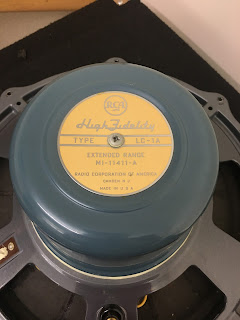CMI/IUPUI Speaker Restoration Project: Speakers
The heart of the speaker. Stylish.
|
 |
| The tweeter nestled inside the subwoofer cone. |
Dynamic speaker design basically boils down to a few basic
components: a permanent magnet, a “voice coil” that is capable of producing a
magnetic field, and some kind of vibrating material. It relies on the vibration
caused by alternating current passing through the voice coil creating a
magnetic field that interacts with the magnetic field of the larger, permanent
magnet. This vibrates the air between the two, causing the vibrating material
to move back and forth and produce sound. Modern speakers utilize two separate
configurations of this vibrating apparatus, the subwoofer for lower frequencies
and the tweeter for the higher ones. Tweeters and subwoofers are often combined
in order to maximize the frequency range one speaker can put out, with the
smaller tweeter either nestled in the center of the larger subwoofer cone or placed
next to it, depending on the speaker design.
 |
| The heart of the speaker. Stylish. |
How, then, does the tweeter and subwoofer receive the information
they need to produce music? Physical vibrations from a microphone, digital data
from a computer, or any other musical data that is sent to the speaker must be
first converted to an electrical signal that the speaker can understand. This
electrical data is sent to the speaker’s crossover, a filter that sorts the
high and low frequencies and sends them into the proper part of the speaker.
Crossovers are often a combination of capacitors and inductors nestled outside
the speaker’s cone and are responsible for the performance and safety of each
speaker part (particularly the subwoofer, which might overheat if given too
much high frequency signal).
Due to the nature of vibration, each forward vibration of
the speaker will produce an equal and opposite backward vibration headed
towards the speaker wall. Without proper highly absorptive material, these
vibrations bounce back from the wall and interfere with the vibrations heading
forward. This interference can heavily distort the sound, both due to the phase
shift and some diffraction from hitting the corners of the speaker wall. This
is why speaker design and placement are key to get optimal sound in a
performance space. The best speakers will be designed either to reduce phase
shift or have enough absorption to negate the rebounding waves. They also need
to be placed in such a way that sound waves that bounce off walls behind them
have minimal interference with the sound being heard.
 |
| No sharp edges minimizes frequency diffraction |
How do these factors play a part in the speakers we’re
restoring? Harry F. Olson (mentioned in previous blog posts) did extensive
research in speaker cabinet design that minimized distortion, resulting in the
rounded design of our speakers. He concluded that the diffraction of
frequencies was a result of the waves bouncing off sharp 90-degree angles in
the speaker cabinet, so one without these harsh edges could resonate pleasantly
with minimal distortion of sound. Our speakers also have a uniquely textured
dome tweeter nestled inside the subwoofer cone so that the speaker as a whole
looks simple, clean, yet unique with its wooden case.
When setting up a sound system, there are still so many
other factors to consider when trying to recreate the perfect listening
environment, something audio engineers struggle even to this day to achieve.
While we might not see much of this rounded design in the future (due to the
sheer logistics on how one could mass produce speakers like this), it’s
fascinating to physically see how small details can have great contributions
towards sound quality.
If you’re interested in more in-depth explanations on how
speakers function, I’ll leave the links to some of my sources (including Olson’s
research) down below:
https://soundphysics.ius.edu/?page_id=1343
Basis of Crossover in speakers:
https://www.audioholics.com/loudspeaker-design/crossover
Research on Speaker Cabinet design:
I also wanted to share an really interesting video on how a speaker cone is manufactured by How It's Made:



Comments
Post a Comment